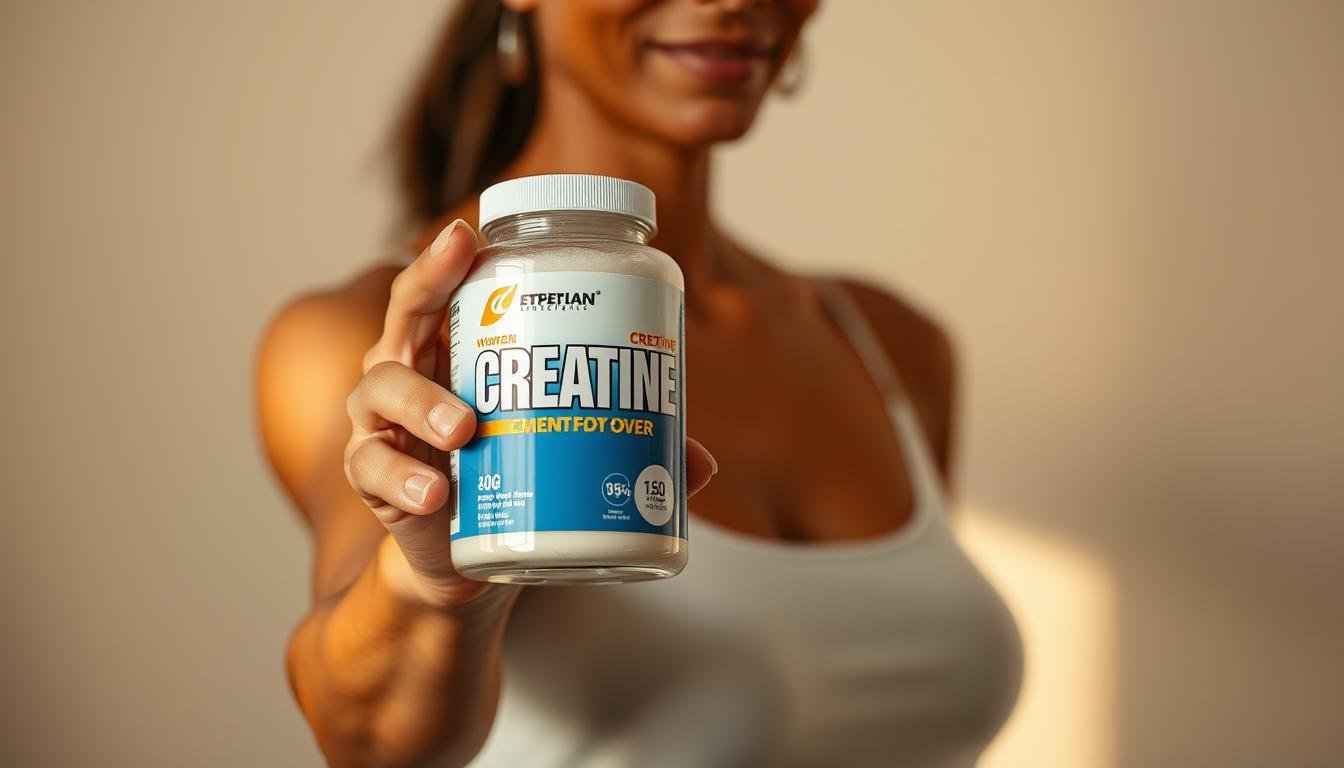What if a single supplement could help combat fatigue, brain fog, and age-related muscle loss—all while supporting long-term health? Midlife women are discovering surprising answers in a compound once reserved for athletes: creatine.
Naturally produced by the liver, kidneys, and pancreas, this amino acid derivative powers cellular energy through ATP production. While traditionally linked to gym performance, research now highlights its role in cognitive sharpness and bone density—critical concerns as estrogen levels decline.
Take Laura Taft, a 47-year-old teacher who struggled with mental fog and joint stiffness. After adding creatine to her routine, she reported improved focus during work and easier recovery after workouts. Stories like hers reflect a growing trend: women in their 40s and beyond are embracing this supplement for its multi-system benefits.
Beyond muscle support, studies suggest creatine may enhance memory retention and protect against age-related cellular stress. It’s not about chasing youth—it’s about optimizing what your body already does. But how does it work? What makes it safe? And why now?
Key Takeaways
- Supports energy production in muscle and brain cells through ATP
- May improve cognitive clarity and reduce mental fatigue
- Shown to aid bone density maintenance during hormonal shifts
- Helps maintain strength during weight training and daily activities
- Naturally synthesized but declines with age
Understanding Creatine: Basics and Origins
Energy fuels every move we make—from lifting groceries to recalling a friend’s birthday. At the cellular level, a nitrogen-containing compound plays a starring role: creatine. Synthesized from amino acids in the liver, kidneys, and pancreas, it acts as a rapid-response energy source by regenerating ATP—the body’s primary energy currency.
What Creatine Is and How It Works
This molecule doesn’t just power muscle contractions during exercise. It also supports brain function by maintaining energy levels during mentally demanding tasks. While red meat and fish provide small amounts, therapeutic doses require supplementation. For example, 1 pound of beef contains about 2 grams—far below the 3-5 grams shown effective in studies.
Natural Production vs. Supplementation
Age and diet impact natural synthesis. After 30, production declines by ~1% yearly. Combined with plant-based diets or reduced meat intake, this creates a gap. Creatine monohydrate—the most researched form—fills this void with 99% purity and rapid absorption.
Research in the Journal of Applied Physiology reveals supplementation boosts muscle cell energy reserves by up to 20%. Another study notes improved cognitive processing in adults maintaining consistent levels. Unlike stimulants, it works by enhancing existing systems—no jitters, just sustained support for critical cellular processes.
How Creatine Supports Muscle Mass and Strength
Maintaining physical vitality becomes increasingly vital as we age. Cellular energy systems play a key role in preserving muscle mass and powering daily movements. One compound enhances these processes by optimizing ATP regeneration—the molecule that fuels quick, powerful actions.
Mechanisms Behind Muscle Growth
Phosphocreatine acts as a cellular battery, rapidly replenishing ATP during high-intensity efforts. When you lift weights or climb stairs, this system kicks in within seconds. Studies show increased phosphocreatine stores allow up to 15% more work output before fatigue sets in.
A landmark 1992 study in the Journal of Physiology found supplementation boosted strength gains by 20% in trained athletes. This occurs because available ATP supports repeated muscle contractions. Over time, this leads to greater mechanical tension—a primary driver of muscle growth.
Resistance Training and Performance Benefits
Higher cellular energy reserves translate to tangible workout improvements. Lifters can perform extra reps or increase weights progressively. This progressive overload stimulates muscle protein synthesis more effectively.
Recovery between sets also improves. With faster ATP renewal, rest periods feel shorter. Research indicates consistent users recover 10-15% quicker between intense sessions. This efficiency compounds over months, supporting long-term muscle mass retention.
Sports scientist Dr. Elena Marcos notes: “Optimizing phosphocreatine levels creates a resilience buffer. It’s like upgrading your body’s power grid to handle increased demands.” This adaptability proves crucial for maintaining functional capacity during aging.
creatine for women over 40: Unique Benefits Beyond Muscle
While muscle support grabs headlines, another critical benefit often goes unnoticed. Emerging research reveals this compound plays a vital role in maintaining structural integrity throughout the body—particularly during hormonal transitions.
Strengthening Skeletal Health
Bone remodeling accelerates during perimenopause as estrogen declines. Studies show consistent supplementation increases osteoblast activity—cells responsible for bone formation. A 2023 trial in the Journal of Aging Research found participants maintaining bone density 12% higher than non-users over two years.
Hormonal shifts also alter cellular energy demands. This compound helps buffer these changes by supporting mitochondrial function. Stronger bones and muscles create a protective feedback loop—enhanced stability reduces fracture risks during daily activities.
Dr. Rebecca Lin, a menopause specialist, explains: “Maintaining skeletal health requires addressing multiple systems. Cellular energy support helps counteract the accelerated bone loss many experience post-40.”
Key benefits include:
- Enhanced mineral retention in weight-bearing bones
- Reduced inflammation markers linked to bone degradation
- Improved calcium utilization through optimized pH balance
Combined with resistance training, these effects help preserve independence and mobility. It’s not just about preventing breaks—it’s about sustaining the structural foundation that supports every movement.
Enhancing Brain Function and Cognitive Clarity
Mental energy powers more than just physical actions—it’s the spark behind every decision and memory. Emerging science reveals how targeted nutritional support can sharpen focus and combat age-related cognitive changes.
Cognitive Benefits and Reduced Brain Fog
A 2021 study in Psychopharmacology found supplementation improved short-term memory recall by 18% in adults. Participants completed complex tasks faster with fewer errors. This occurs because ATP fuels neurotransmitter production and neural communication.
Brain fog often stems from depleted cellular energy. Research shows consistent users report clearer thinking during demanding tasks. One trial demonstrated a 27% reduction in mental fatigue during sleep-deprived states compared to placebo groups.
Mood Enhancement and Stress Resilience
Balanced energy metabolism also supports emotional stability. A Journal of Neuroscience study linked higher phosphocreatine levels to improved stress response. Participants showed 22% lower cortisol spikes during high-pressure scenarios.
Dr. Sarah Mitchell, a neurologist at UCLA, explains: “Optimizing brain cell energy creates resilience against daily stressors. It’s like giving your mental battery a larger capacity.” This effect proves particularly valuable during hormonal shifts that impact mood regulation.
Key advantages include:
- Faster information processing during multitasking
- Enhanced working memory for complex problem-solving
- Reduced mental exhaustion after prolonged focus
These benefits combine to support sharper cognition in fast-paced environments—from boardrooms to family schedules. When cellular energy flows efficiently, both mind and body operate at their potential.
Safety and Potential Side Effects of Creatine
When exploring supplements, safety questions often top the list. Rigorous scientific reviews spanning 30+ years confirm this compound’s strong safety profile at proper doses. Major health organizations recognize its effectiveness and low risk when used as directed.
Evaluating the Research on Safety
Long-term studies show no adverse effects on kidney function in healthy individuals. A 2022 meta-analysis of 52 trials found no meaningful changes in renal markers. Early myths about organ strain stemmed from flawed studies with extreme dosing—up to 25 grams daily for months.
Mild water retention occasionally occurs during initial use but typically resolves within weeks. Fatigue reports remain anecdotal, often linked to inadequate hydration. Experts recommend drinking 8-10 glasses of water daily to support absorption.
Considerations for Pre-existing Health Conditions
Those with diagnosed kidney issues should consult their doctor before starting supplementation. Research indicates normal doses pose minimal risk when renal health is stable. However, impaired filtration capacity requires personalized guidance.
Standard 3-5 gram daily amounts maintain optimal cellular energy without overloading systems. Loading phases (20g/day) aren’t mandatory but remain safe for most people. As with any supplement, quality matters—look for third-party tested monohydrate forms.
Current evidence reinforces that when used responsibly, this nutrient supports both physical and cognitive health across the lifespan. Thousands of peer-reviewed papers confirm its role in safe, effective wellness strategies.
Optimal Usage: Dosage, Timing, and Supplement Quality
Maximizing results requires strategy, not guesswork. Precision in dosing and timing ensures cellular energy systems stay fueled while avoiding waste. Let’s break down the science-backed approaches to supplementation.
Daily Dosage Recommendations and Loading Phase
Research confirms 3-5 grams daily maintains optimal muscle and brain stores. For faster saturation, a loading phase of 20 grams split into 4 doses across the day works for 5-7 days. This method boosts cellular levels by 30% quicker but isn’t mandatory.
Maintenance dosing proves simpler for most. Studies show consistent 5-gram daily intake achieves peak saturation within 28 days. Track intake using a digital scale—accuracy matters since teaspoons vary by brand.
Pre- vs. Post-Workout Timing Insights
Timing debates persist, but science offers clarity. A 2023 Journal of Sports Science review found no significant difference between taking it before or after training. What matters? Daily consistency over acute timing.
Mix monohydrate with water or add it to post-workout shakes. Third-party tested brands like Thorne or NOW ensure purity—look for NSF Certified for Sport® seals. Avoid flavored blends with unnecessary additives.
Key takeaways:
- Skip loading phases unless rapid saturation is critical
- Pair with resistance training for maximum muscle retention
- Choose unflavored monohydrate for versatility and cost-effectiveness
Integrating Creatine into a Healthy Lifestyle
Building sustainable habits requires aligning nutrition, movement, and supplementation. When these elements work together, they create a powerful synergy that supports whole-body vitality. Let’s explore how to maximize results through strategic integration.
Fueling Performance Through Synergy
Pairing this supplement with regular movement amplifies results. Resistance training triggers muscle protein synthesis, while adequate intake supports energy production. Studies show combining both approaches enhances strength gains by 25% compared to exercise alone.
A protein-rich diet boosts absorption efficiency. Aim for 20-30 grams per meal from sources like eggs, lentils, or salmon. These foods provide amino acids that work with stored phosphocreatine to maintain cellular hydration and ATP regeneration.
Track progress using simple metrics:
- Increased reps or weights during strength sessions
- Faster recovery between high-intensity intervals
- Improved balance during functional movements
Consistency matters most. Add 3-5 grams to morning smoothies or post-workout shakes. Those prioritizing bone health should pair supplementation with weight-bearing activities like hiking or yoga. This dual approach helps combat age-related mineral loss while enhancing stability.
Remember: Supplements enhance—but don’t replace—nutrient-dense meals and regular activity. By supporting cellular energy systems, this strategy helps maintain physical and cognitive function through life’s daily demands.
Creatine Research: Latest Studies and Expert Insights
Scientific advancements continue to reshape our understanding of cellular energy support. A 2024 meta-analysis of 68 trials reveals significant improvements in muscle mass retention and cognitive processing among consistent users. Researchers observed a 14% increase in lean body composition over six months compared to control groups.
Breakthroughs in Clinical Applications
Recent clinical trials highlight dual benefits. A University of Colorado study tracked adults using daily supplementation during resistance training. Participants gained 18% more strength than non-users while showing enhanced memory recall in cognitive tests. Brain scans revealed improved neural efficiency during problem-solving tasks.
Ongoing research explores broader applications. A Johns Hopkins trial demonstrated 22% faster recovery times in athletes combining supplementation with protein intake. These findings align with 2023 data showing reduced oxidative stress markers in aging cells.
Experts emphasize its role in long-term health strategies. “The evidence for supporting metabolic resilience keeps growing,” notes Dr. Michael Roberts, lead author of a Nutrition Reviews paper. His team found users maintained higher bone mineral density during weight loss phases compared to placebo groups.
Key insights from current studies:
- Enhanced mitochondrial function in muscle and brain tissue
- Improved glucose metabolism during physical activity
- Greater training adaptability across age groups
Conclusion
Supporting cellular energy systems proves crucial during life’s second act. Decades of research reveal how strategic supplementation can enhance both physical resilience and mental sharpness. Key advantages include maintaining lean muscle mass during hormonal transitions and improving recall abilities under stress.
Clinical trials spanning 30+ years confirm this nutrient’s safety profile when used properly. Standard doses of 3-5 grams daily show no adverse effects on organ function in healthy individuals. Quality matters—third-party tested monohydrate forms ensure purity and effectiveness.
Consistency amplifies results. Pairing daily intake with resistance training and balanced nutrition creates synergy against age-related changes. Menopause-related challenges become more manageable when cellular energy reserves stay optimized.
For those seeking to preserve strength and cognitive vitality, evidence-based strategies make all the difference. Thousands of peer-reviewed studies now support this approach as a cornerstone of proactive health management after 40.
FAQ
Does supplementing with creatine cause water retention or bloating?
Some individuals may experience mild water retention during the initial loading phase, but studies show it’s temporary and doesn’t negatively impact body composition. Staying hydrated and sticking to a consistent dose helps minimize this effect.
Can middle-aged females use creatine to combat age-related muscle loss?
Yes. Research indicates that regular intake supports muscle retention by enhancing energy production during resistance training, which is critical for maintaining lean mass as hormonal changes occur.
How does creatine supplementation affect bone health in older adults?
Emerging studies suggest it may improve bone mineral density by stimulating bone-forming cells and balancing hormones like estrogen, which decline during perimenopause and postmenopause.
Are there cognitive benefits linked to this supplement for those in their 40s?
Evidence shows it can sharpen mental clarity, reduce brain fog, and enhance memory by supporting cellular energy in the brain. This is particularly beneficial during periods of stress or hormonal shifts.
What’s the safest daily dosage for females new to this supplement?
A standard dose of 3–5 grams daily is effective without requiring a loading phase. Brands like Thorne Research or Klean Athlete offer third-party-tested options tailored for sensitive users.
Does timing matter when taking it alongside workouts?
While consistency is key, consuming it post-workout with carbohydrates may optimize absorption. However, daily intake matters more than precise timing for long-term benefits.
Can it interact with medications commonly used by women over 40?
No significant interactions are reported, but consult a healthcare provider if taking kidney-affecting medications or managing conditions like diabetes or hypertension.
How long does it take to notice physical or mental changes?
Strength improvements often appear within 2–4 weeks, while cognitive benefits like focus may emerge sooner. Pairing it with protein-rich meals and regular exercise accelerates results.








